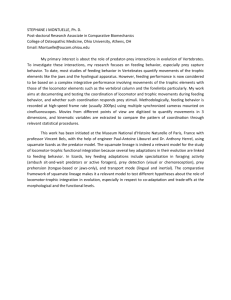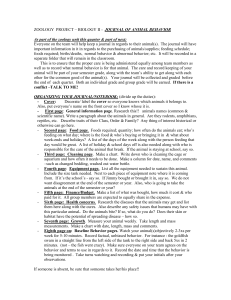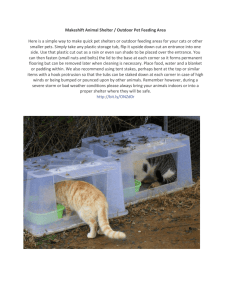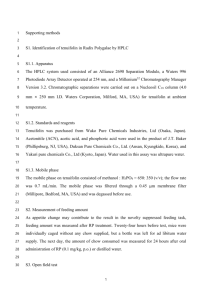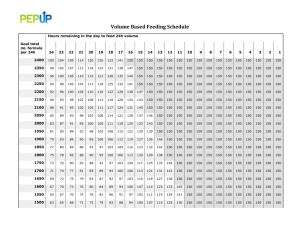changes in the hematological parameters of rabbits given - uni
advertisement
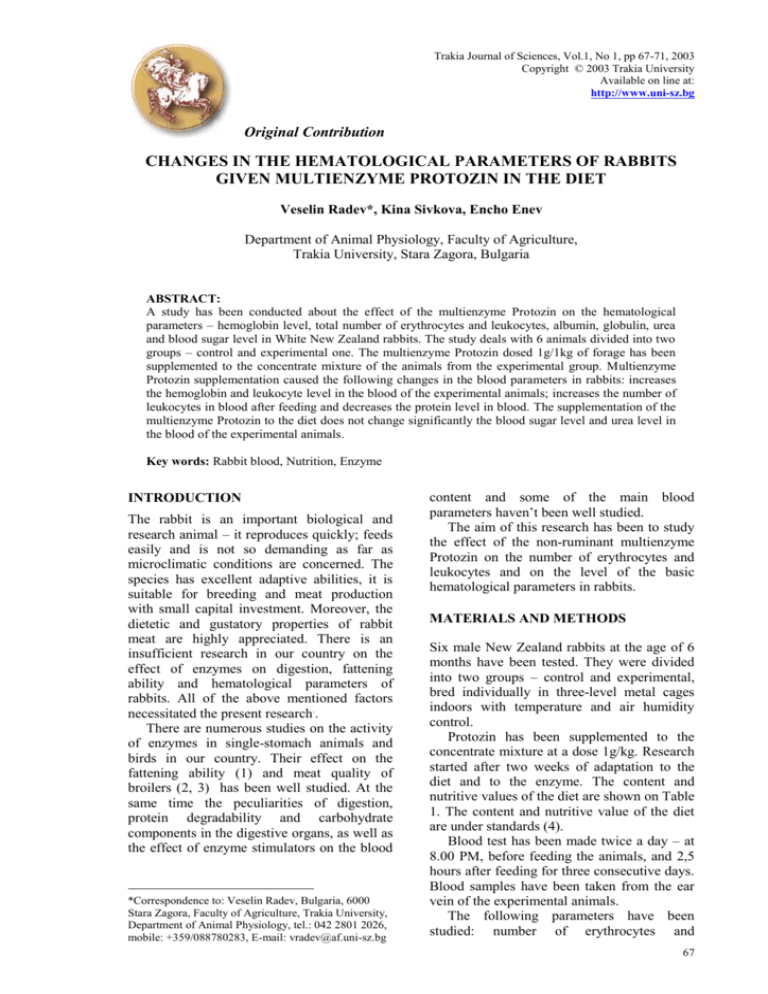
Trakia Journal of Sciences, Vol.1, No 1, pp 67-71, 2003 Copyright © 2003 Trakia University Available on line at: http://www.uni-sz.bg Original Contribution CHANGES IN THE HEMATOLOGICAL PARAMETERS OF RABBITS GIVEN MULTIENZYME PROTOZIN IN THE DIET Veselin Radev*, Kina Sivkova, Encho Enev Department of Animal Physiology, Faculty of Agriculture, Trakia University, Stara Zagora, Bulgaria ABSTRACT: A study has been conducted about the effect of the multienzyme Protozin on the hematological parameters – hemoglobin level, total number of erythrocytes and leukocytes, albumin, globulin, urea and blood sugar level in White New Zealand rabbits. The study deals with 6 animals divided into two groups – control and experimental one. The multienzyme Protozin dosed 1g/1kg of forage has been supplemented to the concentrate mixture of the animals from the experimental group. Multienzyme Protozin supplementation caused the following changes in the blood parameters in rabbits: increases the hemoglobin and leukocyte level in the blood of the experimental animals; increases the number of leukocytes in blood after feeding and decreases the protein level in blood. The supplementation of the multienzyme Protozin to the diet does not change significantly the blood sugar level and urea level in the blood of the experimental animals. Key words: Rabbit blood, Nutrition, Enzyme INTRODUCTION The rabbit is an important biological and research animal – it reproduces quickly; feeds easily and is not so demanding as far as microclimatic conditions are concerned. The species has excellent adaptive abilities, it is suitable for breeding and meat production with small capital investment. Moreover, the dietetic and gustatory properties of rabbit meat are highly appreciated. There is an insufficient research in our country on the effect of enzymes on digestion, fattening ability and hematological parameters of rabbits. All of the above mentioned factors necessitated the present research.. There are numerous studies on the activity of enzymes in single-stomach animals and birds in our country. Their effect on the fattening ability (1) and meat quality of broilers (2, 3) has been well studied. At the same time the peculiarities of digestion, protein degradability and carbohydrate components in the digestive organs, as well as the effect of enzyme stimulators on the blood *Correspondence to: Veselin Radev, Bulgaria, 6000 Stara Zagora, Faculty of Agriculture, Trakia University, Department of Animal Physiology, tel.: 042 2801 2026, mobile: +359/088780283, E-mail: vradev@af.uni-sz.bg content and some of the main blood parameters haven’t been well studied. The aim of this research has been to study the effect of the non-ruminant multienzyme Protozin on the number of erythrocytes and leukocytes and on the level of the basic hematological parameters in rabbits. MATERIALS AND METHODS Six male New Zealand rabbits at the age of 6 months have been tested. They were divided into two groups – control and experimental, bred individually in three-level metal cages indoors with temperature and air humidity control. Protozin has been supplemented to the concentrate mixture at a dose 1g/kg. Research started after two weeks of adaptation to the diet and to the enzyme. The content and nutritive values of the diet are shown on Table 1. The content and nutritive value of the diet are under standards (4). Blood test has been made twice a day – at 8.00 PM, before feeding the animals, and 2,5 hours after feeding for three consecutive days. Blood samples have been taken from the ear vein of the experimental animals. The following parameters have been studied: number of erythrocytes and 67 V. RADEV et al. leukocytes, hemoglobin level, albumin, globulin, protein, urea and blood sugar. The number of leukocytes and erythrocytes has been calculated by Thoma and Burker chamber – using a method described by (5). Protein, urea and blood sugar have been determined by using standard methods described by (6). The data in the present study have been processed by means of a computer aided kit for statistical analysis Statistics and Microsoft Excel – version 2000. The graphic presentations have been made by means of the same programmes. Table 1. Content and nutritive value of the diet. Standard Alfalfa hay Barley mill Wheat mill Salt Total Dry Matter KE Crude Fiber 36-66 35 Ca P 1.7-2.25 0.7 Crude Protein 37-49 20.58 195-235 119 0.9-1.2 1.9 0.5-06 0.3 61.6 0.92 5.81 3.92 0.07 0.27 61.6 0.88 9.45 2.17 0.05 0.32 242.2 2.50 35.84 41.09 2.02 0.98 RESULTS AND DISCUSSION All results in the present study are given in Table 2 and Figures 1 - 8. Changes in hemoglobin level of the test animals are shown on Figure 1 and Table 2. Significant increase in the hemoglobin level in the blood of the test animals has not been observed . The hemoglobin level in the blood of the test animals is 74.0 g/l before feeding and in the control ones - 68.4 g/l. The tendency for higher content of hemoglobin is still preserved 2.5 hours after feeding the animals – in the experimental group the hemoglobin level is 67.9 g/l and in the control one – 56.8 g/l. Table 2. Blood parameters. PARAMETERS n PROTOZIN C xS x Before feeding Total protein (g/ l) Albumins (g/ l) Globulins (g/ l) Urea (mmo/ l) Blood sugar (mmo/ l) 3 3 3 3 3 Total protein (g/ l) Albumins (g/ l) Globulins (g/ l) Urea (mmo/ l) Blood sugar (mmo/ l) 3 3 3 3 3 а - р 0.05, 68 62.00 4.16 11.63 34.17 2.54 12.86 27.83 1.70 10.60 16.43 5.07 0.48 6.49 6.46 0.24 5 h after feeding 54.33 1.76 а 5.62 33.40 2.20 11.41 20.93 3.90 32.28 9.76 6.40 0.36 14.46 7.18 0.60 CONTROL GROUP xS x C 63.00 0.58 34.73 0.86 28.27 0.32 5.30 0.59 6.39 0.22 1.59 4.27 1.95 19.15 6.08 61.33 0.33 33.17 0.84 28.17 1.14 6.77 0.48 7.22 0.67 0.94 4.37 7.01 12.39 15.95 (control versus experimental group) Trakia Journal of Sciences, Vol.1, No 1, 2003 V. RADEV et al. (g/l) Control Protozin 80 70 60 50 40 30 20 10 0 before feeding 2.5 h after feeding Figure 1.Blood hemoglobin level in animals from the control and the experimental group. Control Protozin 6 mil. in mm 3 5 4 3 2 1 0 before feeding 2.5 h after feeding Figure 2. Number of erythrocytes in the blood of animals from the control and the experimental group. Control Protozin 25 тhous. mm3 20 15 10 5 0 before feeding 2.5 h after feeding Figure 3. Number of leucocytes in the blood of animals from the control and the experimental group. Control Protozin g/l The number of erythrocytes (Figure 2) is in positive correlation with the higher hemoglobin level in the blood of the experimental animals. The number of erythrocytes in the experimental group is 5.96x1012/l before feeding and in the control one – 4.99x1012/l. There is no significant difference in the number of erythrocytes after feeding. The changes in the leukocyte number in the blood of the experimental animals before and after feeding are shown on Figure 3. The number of leukocytes in the experimental animals before and after feeding is slightly higher. Values are 13.8x10/l and 23.5x10/l respectively. The number of leukocytes in the experimental group is 13.5x10/l before feeding and 20.3x10/l after feeding. An increase in number of leukocytes in the blood of the animals from both groups has been observed – alimentary leukocytosis. The supplementation of the enzyme Protozin has not changed significantly the level of the total protein, albumin and globulin in the blood of the experimental animals (Fig. 4, 5 and 6, table .2). The total protein in blood before feeding is within 62.00 g/l in the experimental and 63.00 g/l in the control group. The level of the protein slightly decreases in both groups two hours and a half after feeding – 54.30 g/l in the experimental and 61.33 g/l in the control group. The albumin level in the blood of the experimental group is 34.17 g/l before feeding. In the blood of the control one the albumin level is 37.73 g/l. The supplementation of the multienzyme Protozin has increased the level of albumin in the blood of the experimental animals 2.5 hours after feeding. Though the opposite tendency has been observed about the level of globulin (Figure 6, Table 2), there have been no significant differences in the globulin level for both groups in the hours before feeding. The values are 27.83 g/l and 28.27 g/l respectively for the animals in the experimental and the control group. The supplementation of the enzyme has decreased the globulin level in the blood of the experimental animals two hours and a half after feeding – 20.93 g/l and the values for the animals in the control group are higher – 28.17 g/l. No significant differences have been observed in the blood urea level after supplementing the enzyme (Figure 7, Table 2) 64 62 60 58 56 54 52 50 48 before feeding 2.5 h after feeding Figure 4. Total protein level in the blood of animals from the control and the experimental group. Trakia Journal of Sciences, Vol.1, No 1, 2003 69 V. RADEV et al. g/l Control Protozin 35 34.5 34 33.5 33 32.5 32 before feeding 2.5 h after feeding Figure 5. Albumin level in blood - control and experimental group. g/l Control Protozin 30 25 20 supplementing the enzyme (Figure 7, Table 2). The values indicating urea content in animals from the experimental group are 5.07 mmol/l before feeding and 6.40 mmol/l 2.5 hours after feeding. Urea level in the control rabbits is 5.30 mmol/l before feeding and 6.77 mmol/l after feeding. Blood sugar level (Figure 8, Table 2) increases in the hours after feeding (2,5 hours) in both groups. Before feeding blood sugar values are 6.46 mmol/l in the experimental group and 6.39 mmol/l in the control one. Two and a half hours after feeding the values are 7.18 mmol/l in the experimental and 7.22 mmol/l in the control group. After the supplementation of the multienzyme no significant changes have been observed in the blood sugar level of the animals from the experimental group in the hours after feeding. 15 CONCLUSIONS 10 5 0 before feeding 2.5 h after feeding Figure 6. Globulin level in blood- control and experimental group. mmol/l Control Protozin 7 6 5 4 3 2 1 0 before feeding 2.5 h after feeding Figure 7. Urea level in blood - control and experimental group. mmol/l Control Protozin 7.4 7.2 7 6.8 6.6 6.4 6.2 6 5.8 REFFERENCES before feeding 2.5 h after feeding Figure 8. Blood sugar level - control and experimental group. 70 The data in the present study are part of a large-scale research about the effect of supplementing multienzymes on the digestive processes, the fattening ability, meat quality and the hematological parameters in rabbits. On the basis of the conducted study and the obtained results the following conclusions about the effect of the multienzyme Protozin on the hematological parameters of rabbits can be drawn: 1. The supplementation of the multienzyme Protozin causes the following changes in the blood parameters of rabbits: 1.1. Increases the hemoglobin and leukocyte level in the blood of the experimental animals. 1.2. Increases the number of leukocytes in blood after feeding and decreases the protein level in blood. 1.3. The supplementation of the multienzyme Protozin in the diet does not change significantly the blood sugar and urea level in the blood of the experimental animals. 1. Pointilart, A., Importance of Phytases and cereal phytases in the feeding of the 1st symposium, Kartause, Ittingen, Switzerland, 1993. 2. Um, J. S., Ahn, S. H. and Paik, I. K., Effect of Microbial Enzyme Supplementation on the Performance of Laying Hens Fed Diets Containing Different Levels of Wheat Asian. Australasian J Animal Science, 11 (6): 702707, 1998. Trakia Journal of Sciences, Vol.1, No 1, 2003 V. RADEV et al. 3. Friesen, O. D., Guenter, W., Marquardt, R. R. and Rotter, B. A., The effect of enzyme supplemntation on the apparent metabolizable energy and nutrient digestibilites of wheat, barley, oats and rye for the young broiler chick. Poultry Sci, 71 : 1710 – 1721, 1992. 4. Grigorov I., Rabbit breeding. Zemizdat, Sofia, 1999. 5. Petkov, A., Enev, E., Sivkova, K., Varliakov, I., Radev, V., Manual for animal physiology training. KOTA, Stara Zagora, 2001. 6. Ibrishimov, N., Lalov, Hr., Clinical laboratory research in veterinary medicine. Zemizdat, Sofia, 1984. Trakia Journal of Sciences, Vol.1, No 1, 2003 71

